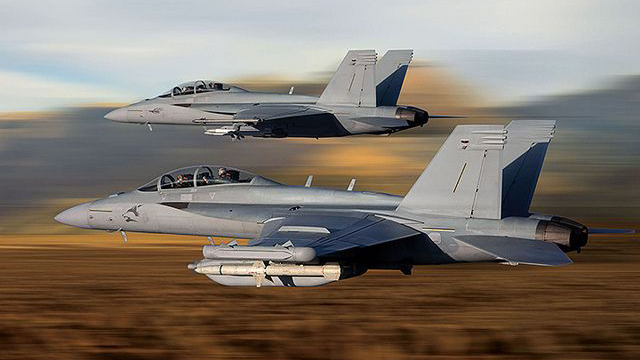The hubbub last week over President-elect Donald Trump’s criticism of Boeing and the cost of Air Force One overshadowed a potentially thornier issue for a leader who has pledged to keep jobs in America: Boeing wants to build F/A-18 fighter jets in India.
St. Louis is now the only place where F/A-18 Super Hornets are assembled, although parts come from around the country. The Super Hornet and its electronic warfare variant, the EA-18G Growler, employ thousands here at Boeing and its contractors.
While an Indian plant would at first make planes for India, it might eventually make them for other nations, too, raising questions about jobs in St. Louis over the long term.
He’s made it clear that defense companies that want to sell fighter planes to India will have to make them in India, and share technical knowledge with Indian business partners. In effect, the company that wins the Indian contract would help create its own competitor.
Lockheed Martin, Boeing’s archrival for international sales, has proposed to build an F-16 Fighting Falcon line in India if it wins the contract. Boeing also faces possible competition from the Swedish SAAB Gripen and French Dassault Rafale fighters.
India wants roughly 200 fighters to update its air force. Super Hornets sold to the U.S. Navy carry a price tag of about $70 million each.
Talks are in early stages, and India hasn’t yet issued a formal call for bids. An Indian assembly plant is unlikely to be up and running until well into the next decade.
“Co-production” is a frequent part of international defense sales. Manufacturers agree to buy parts for the product from the purchasing nation. But building the plane itself abroad is unusual.
Asked about an Indian operation’s impact on employment here, Boeing said its St. Louis production line has a “solid future” with enough orders to carry it “well into the 2020s.”
“We’re optimistic about the opportunity to continue our work in St. Louis and add a new production line in India which would also create more opportunities for our entire Super Hornet supply chain,” the company said in an email.
The Defense Department, under President Barack Obama, seems happy to go along. Although India is not an American ally, relations have warmed in recent years and military cooperation has been increasing.
Defense Secretary Ash Carter, speaking to Congress last spring, noted “growing enthusiasm of U.S.-India partnership” and predicted “a landmark co-production agreement that will bring our two countries closer together and make our militaries stronger.”
President-elect Trump, however, has pledged to retaliate against companies that move American jobs abroad. It’s unclear how his administration might view an Indian Super Hornet or F-16 plant.
“Given the numerous tweets and comments over several weeks, I wouldn’t be surprised if this is brought up or revisited,” said Jeff Windau, an analyst who follows Boeing for Edward Jones Investments in Des Peres.
On one hand, the Indians would buy another nation’s fighters if Boeing or Lockheed refused to build in India. The Hornets or F-16s built in India would still draw parts from the U.S.
But the Indian plant, and the industry it would help create, could eventually pull orders and jobs from America, especially if it began making Super Hornets for other countries.
The Indians would also get a close-up view of very sophisticated American technology and manufacturing techniques. “Absolutely, it’s sensitive technology,” said Loren Thompson, defense analyst and chief operating officer at the Lexington Institute in Northern Virginia. “The Super Hornet is not stealthy, but its electronics and weapons systems are state of the art.”
The Super Hornet’s future was once in doubt, but Boeing recently has been piling up orders. The Obama administration in September approved the sale of 28 to Kuwait, and Canada last month announced plans to buy 18 more. Boeing has enough orders to keep the St. Louis line running well into the next decade.
By contrast, the Lockheed F-16 program is winding down in the U.S. “I think it would be easier for Lockheed to set up an F-16 line in India than for Boeing to do it for the Super Hornet,” said Thompson. “It just seems unlikely that planes being produced in the U.S. would be manufactured in India.”
Lockheed wants to use its current F-16 plant to expand production of the new F-35 joint strike fighter, he noted.
Union leaders in St. Louis were just learning of the Indian issue last week, from news reports. “We usually find out after the thing is settled,” said Steve McDerman, president of the International Association of Machinists Local 837 in St. Louis.
India in this decade has purchased 10 Boeing C-17 Globemaster strategic airlifters, eight Boeing P-8 surveillance and anti-submarine aircraft as well as St. Louis-made Harpoon missiles from Boeing. Boeing teamed with an Indian company to build parts for Apache and Chinook military helicopters and its 787 Dreamliner airliner in India. A plant in Hyderabad, India, will eventually be the sole source for Apache fuselages globally.
Trump took Boeing to task last week. On Wednesday, he tweeted that he would cancel a proposal for two new 747s to replace the aging Air Force One planes that carry the president. He put the cost at $4 billion, although other analysts say the final cost would probably be less. He later called the price ridiculous and said Boeing was “doing a little bit of a number.”
The tweet came minutes after the Chicago Tribune quoted Boeing CEO Dennis Muilenburg defending free trade with China, which is a big customer for Boeing commercial aircraft.
Trump has suggested slapping tariffs on Chinese goods to retaliate against what he calls unfair Chinese trade policy and currency manipulation.









